  
|
HDTV Diary
alaska
PHOTOS BY BILL ZARCHY, EXCEPT AS NOTED

Panorama from the Million-Dollar Bridge
Wednesday 24 May 2000 On the road again! 9 am flight with Randy and Larry from SFO to Seattle and Anchorage, arriving very late. Quick run to a nearby gate for a connection with another Alaska Airlines flight to Cordova, intense argument with the airline gate agent, who insists I check our HDTV camera, which is in a soft carryon case. "That won't fit in the overhead bin and there's no extra room -- the flight is full, sir," I am told. "But, ma'am, this is a $100,000 television camera which is not packed to go in the hold. There's no way......" Fortunately, the flight attendant on the plane comes to my rescue. The flight isn't even half full, despite what the gate agent says, and there's plenty of room. We meet Jon McDonald, who's flown in from Austin, and Kat Brady, our Anchorage-based Production Manager, on board (despite the fact that the same gate agent had told us that they hadn't checked in yet). Short flight to Cordova, a small fishing village on the Alaska coast Southwest of Anchorage. Winter population 1500, summer population about double that. Amazingly, all our gear and luggage has arrived with us, despite the short turnaround in Anchorage. But my poor suitcase, which was previously sullied and soiled by Continental, has now been damaged by Alaska Airlines. The big flat pocket on the side is hanging open and empty. Upon inspection, however, nothing is torn, but the zipper on that pocket has been torn from its seams with great force. Two things missing: a small empty backpack, which arrives on its own later that night, and a short strap used to attach another bag on the side. The airline pays me for the loss of the strap and finds a seamstress in town to stitch up my bag. We check into the Reluctant Fisherman Inn, surely the oddest name I've ever encountered for a hotel. Our rooms have a view of the harbor and the fishing boats right below us. The town is surrounded by snow-covered mountains -- at sea level !! -- yet the temperature is quite temperate. I speak by phone to Greg Kern, our gaffer in Anchorage, who will be coming to Cordova Friday with two grips and our lighting gear. Cordova is only accessible by air and water, so everything must be flown in. Like many places in Alaska, if you're in a car, you can't get there from here. We have salmon for dinner (when in Alaska, after all...) and do some shooting in the harbor before the sunset at 10:42pm! This far north, the days are very long in May (sunrise is at 4:32 am!) and Larry promises to work us 20 hours a day. During our stay at the Reluctant I wake often during the night and go to the window to watch the sky. In the west it stays light for many hours after the nominal sunset. In fact, it never really gets completely dark. I take a shot of the harbor at 11 pm from the window of my room. |
Cordova, a
fishing village on the
southern coast of Alaska Bill, Jon,
and Randy come off the boat after
shooting scenics PHOTO BY KAT BRADY Sun
glistening on the water in the Orca Inlet The harbor
at 11 pm from my room at
the Reluctant Fisherman. It never
really got dark.

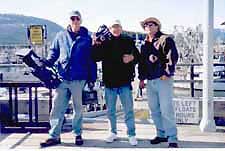
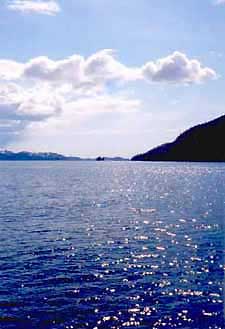
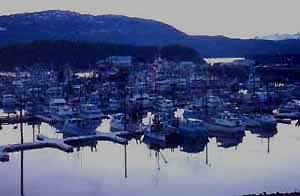
|
Thursday 25 May 2000 Jon and I shoot flavor shots in town while Randy and Larry meet our interview subjects. We shoot the Alaska Hotel sign (which is, inexplicably, upside down), the Cordova Times, some tulips, license plates, interesting wall textures, cars. Our camera attracts attention in this small town, and people stop to ask what we're doing and to chat. A white-haired man comes up and jokingly demands, "What are you doing in my town?" then introduces himself and proceeds to tell us story after story. One is about his early days in Alaska: he's got some Indian blood, he says, and his Indian name is Falling Rock. When he was younger, he used to go wilderness camping quite a bit. One time he went out into the bush, got lost, and wasn't seen again for some months. Though he survived this ordeal, before he was found, his friends were concerned about his safety and got the State to erect signs about his disappearance. To this day, there are signs all over Alaska that advise passersby to "Watch for Falling Rock." We drive to a cannery outside town, shoot a 270 degree pan from the pier nearby and beautiful scenics of the sky and water and mountains, somewhat enhanced by our color "grad" filters. We are surrounded by snowcapped mountains in every direction. We discuss with Kat the possibility of flying to Tutiklet, an Eyak (native Alaskan) village to shoot some cultural scenes, but the village elder who must approve our visit is in Reno on a brief excursion and we must wait for his return. We return to town and Larry gets a message from Kim that Jon needs to get more passport pictures for his visa for India. Apparently they have mistakenly granted him a business visa (instead of a journalist visa, as we were advised) and thus used up the pictures he had sent. We find a photo place, get the pictures, then head to the airport to send them via Alaska Airlines' Gold Streak service to Kim in California. We drive out the Copper River Highway, the only road out of town. At mile 21, where the road crosses the Alaganik River, we stop to watch men scooping "hooligan" fish by net from the river, a dozen at a time (Later Randy finds out these are bulk-frozen and shipped to the US government for feeding captive marine mammals). We drive another 30 miles to Child's Glacier. On the way we shoot snowcapped mountains ("Majestic," says Larry several times) and drive between 7-foot-tall walls of snow (which were plowed just a few minutes before). The road ends near the glacier at the unusually-named Million Dollar Bridge, which sports a funky repair of a secton which has fallen in. We grab some great shots of the glacier as the light fades (by now it's 9:30 at night). We head back to town, assuming we have missed dinner, but we find an open pizza place and secure pizzas, beer, and salads, which we take back to Jon's room and watch today's footage on our 14" monitor. |
In front
of snow-capped mountains in the
hills behind Cordova Setting up
for a pan of the mountains PHOTO BY LARRY LAUTER The sun
glistens on the Alaganik River Our Alaska
crew shot PHOTO BY KAT BRADY


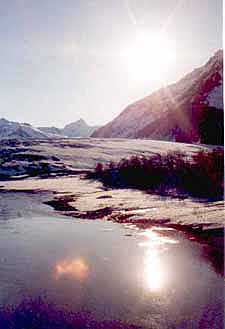
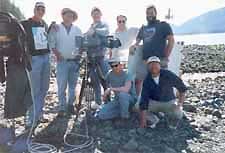
Friday 26 May 2000 Another beautiful day in the neighborhood. We are told repeatedly we brought the good weather with us. We drive out of town in the other direction. The road ends soon at the Orca Lodge, possible location for our interviews. As we arrive, we see a bald eagle perched on a post fairly nearby. Randy is fascinated by these birds, as we all are. After all, they are our national symbol and they carry the mail (well, they are the logo of the Postal Service). We hurry to set up for a shot. Just as we are seconds away from being ready to roll, the eagle turns to Randy, winks derisively, and flies away. He is crushed that we have missed the shot and is sure we would have been ready sooner if we had only been shooting film, instead of video, even a cool format like HDTV. The decision to go HD was made over a month before, so I think "Get over it, Randy." But I vow to get him a great eagle shot before we leave Alaska. Otherwise he will clearly torment me for years to come. We cruise by the elementary school just as students are being let out for the summer. Kat obtains parental permission for us to set up portrait shots of kids, in singles, pairs, and trios. Randy uses the Fart Machine to good effect with some children, but others just won't crack a smile. I remind him of a technique he's used effectively in our long history together, and it works well here: "Okay, look right into the camera, and smile... don't smile... now smile, smile, smile... don't smile!!" Never fails to get a laugh or fun reaction. More shooting on Main Street, this time looking especially for interesting faces. Many townspeople have seen us around by then. Many come up to chat or ask questions or tell us stories. I am taken to meet Florissa and Altana, our interview subjects, and to scout their offices. After lunch we charter a boat for a couple of hours and scoot out onto the Orca Inlet toward Prince William Sound for some shots of the town from the water. We also find some birds and a few sea otters playing in the water, one with a baby on its belly! Great shots of the wildlife, sun sparkling on the water, mountains, boats, islands, etc. A few clouds poke above the horizon, but just for photographic purposes, and they disappear as soon as we get our shots. A gorgeous day to be out on the water. Back to the Reluctant Fisherman. Greg and his crew -- Dave and Chris -- have arrived on the afternoon plane from Anchorage with lighting and grip gear, along with Gary Smith, who runs RANA (the Rural Alaska Native Adult program of Alaska Pacific University), the Internet distance learning program with which Altana and Florissa are involved. We have dinner together, Randy tells jokes (what else?) and we all get acquainted. |
|
No sushi, despite what the sign said: Randy, Bill, Jon & Kat |
|
|
On the street in Cordova PHOTOS BY LARRY LAUTER |
|
|
Saturday 27 May 2000 Back to the Orca Lodge in the morning to set up lights and camera and sound for Gary's interview in the lodge restaurant. This is our first work experience with Greg and his guys, and we can tell in the first five minutes that they "have a clue." Thank God! Because we travel a lot, we can usually tell right away if our local crew members know what they're doing. Usually we are lucky enough to find skilled professionals to fill in the jobs we don't do ourselves, but occasionally we get stuck with some real doozies. Fortunately, that hasn't been the case on this project. The restaurant has a nice rustic feel, a bearskin on the wall, a life preserver that reads "Cordova" on it, old signs, tables, chairs, books, nice windows. We light the room quickly and tastefully, using the depth of the room behind our subject, then we start to roll on Gary's interview. Immediately it is apparent we have a winner here. Gary is articulate, relaxed, and obviously deeply caring about his students and program. Also, he has a broad perspective about the importance of telecommunications in improving the lives of people in rural areas who are otherwise limited in their access to resources outside their immediate communities, a message that is useful for both our stories so far, here in Cordova and in San Marcos de Tarrazú. Outside, we shoot portrait shots of two Native women wearing seal- and otter-skin parkas they have made in traditional ways. Native peoples are allowed by law to continue their old subsistence lifestyles, even to the point of hunting marine mammals that are otherwise protected. This mother-daughter pair epitomize the strong desire to teach the new generations old traditions and techniques. Outside, we do a portrait of a Native man, a fishing guide named Bud, who tells us his elderly parents have just built a new smokehouse. As we are dying to see more traditional culture, we follow him in caravan to their house. The smokehouse is incomplete and looks very modern, but his parents are very friendly and happy to see visitors. "My, my, how many are you?" asks Bud's mom. The nine of us assume she is just overwhelmed by our numbers and our unexpected arrival, but she then presents us each with jars of salmon and Nagoon berry jam she has recently canned. Kat explains later that the jam comes from a plant that yields one berry per bush and must be painstakingly picked in the wild. We do a portrait shot of them and thank them for their kindness. Bald eagles start to fly by overhead, and I shoot several minutes of tape of them soaring in the updrafts and banking in wide turns through the treetops. They are pretty far away, but I feel we have something that will work and alleviate the disappointment of missing the shot yesterday. Bud takes us to his house, where we re-shoot his portrait in his living room, holding his tiny Jack Russell terrier Stormy (Bud's quite a big guy) and flanked by the stuffed heads of a mountain goat and an elk. Bud shows us his garage, an informal neighborhood bar. The walls are covered with autographs and homilies from his friends and a neon sign with a fish picture reading "Buddy's Pro Shop Cordova," a present from some hunting clients from New York. We head back out onto the point near the Orca Lodge and find a whole flock (herd? pod? pride? bunch?) of eagles attracted by a pile of bait fish left on the shore by some fishermen. We see eagles in singles and pairs, diving to the shore, skimming along the water, plucking fish out of the water, feeding their young, perching on posts, soaring, banking, flapping wings, landing, taking off... At last the eagle monkey is off my back: Randy has his wish, and we have many minutes of eagle footage! We drive out of town toward the glacier and try some side roads, hoping to find a bear or some moose, but this time we're not so lucky. Eventually we head back to town for dinner. We go out for sushi at the Chinese-Korean-Japanese-Sushi restaurant. The young blonde waiter brings menus that have mostly standard Chinese dishes. "Do you have sushi?" we ask. "I don't know," he answers, somewhat to our amusement. It turns out he has just started and they haven't had sushi in about 3 years. Kat regales us with horrifying and raunchy stories of being one of the few women working on the Alaska Pipeline 20 years before. |

Panorama at the Alaganik River
|
Sunday 28 May 2000 It's been another gorgeous spring day in Cordova, hitting an unseasonable high of 66 degrees, about the same as back home in San Francisco! Back to the Orca point end of the road in the morning. We shoot our interview with Altana in a gorgeous setting down by the water with snowcapped mountains behind her. She is soft-spoken but articulate about RANA, as well as the importance of the Internet in helping to preserve and pass on Native Alaskan culture. We shoot Florissa's interview in the same place, but we sit her down with her two young sons, John and Calvin, both of whom struggle with her, wriggle, squirm, and run around during the session. At first she is concerned about their activity, but then she realizes that Randy has staged them that way on purpose, and the effect is charming. Altana is a Native Alaskan, an Aleut, and Florissa is of Filipino descent, though the father of her boys is Native. Both women work in town at the office of the Native Village of Eyak, a local tribe. We head there and shoot them working on their computers, showing both the RANA website and other sites devoted to Native Alaskan culture. I am amazed by the wealth of information and resources on the Web about these traditonal cultures. We say goodbye to Altana and Florissa, have lunch, and head back out to the Point to shoot some Native masks and artifacts in a lovely setting on a piece of driftwood next to a creek. We do our obligatory crew shot in the same spot -- about a dozen quick snaps on four or five different still cameras -- and then "That's a wrap on Alaska!!" Monday 29 May 2000 Memorial Day We're done with our work here, but the holiday weekend means we can't get flights home until tomorrow. My traveling companions charter a fishing boat to go out in the ocean after halibut and salmon, but I decide to stay behind. Larry leaves me the key to one of our vans, but I don't feel like driving. After sleeping late, I have breakfast with Kat and Greg and say goodbye for at least the fourth time. I walk around town, buy film, then start briskly up Whitshed Road, the same road where Bud's parents live. This is certainly not the most picturesque road in the area, but I don't care. I am enjoying the beautiful spring day off, the exertion, the crisp, clean air, the smell of woodsmoke, and the glimpses I get of people's homes. At one bend in the road, I hear the unmistakable squeal of Volvo brakes. I turn to see a Volvo wagon of the same vintage as the one we have at home, but this one has clearly suffered through 16 Alaskan winters. "Where ya goin'?" asks the driver with a friendly smile. "Just out for a walk," I reply. "How much further does the road go?" "About 4 miles. I'm goin' there myself. Want a ride?" My urban guard goes up, but this fellow seems harmless. Nevertheless, I refuse politely: "No thanks, I like the exercise." I am enjoying walking and getting to the end isn't important to me. I trudge on, past the Cordova Rose Lodge, the City Camper Park (which is filled with trailers mostly occupied by Russian families), the town junkyard (a huge collection of decomposing automobiles and trucks in various stages of trying to return to the Earth), the Mormon Church (newish and pristine), and numerous homes of various levels of affluence and plumbing sophistication. I stop at Heney Creek and sit for a while to read my book and enjoy the day. I am reading "Way Out Here" by Richard Leo, an account of homesteading in the Alaskan wilderness. Eventually, I get up and return to town. The boys return later from fishing, full of town gossip and fish stories. And laden with over 80 lbs. of halibut which they, or, uh, someone on their boat, caught. They generously split the catch. Tuesday 30 May 2000 As I check out of the Reluctant, I ask about the name. The legend goes, I am told, that a fisherman once found a mermaid on the land near the site of the inn, and after that time, he didn't want to fish anymore. As "evidence," I am shown a brass mermaid statue near a bench facing the harbor behind the Inn. We head for the airport with our gear and coolers of fish. I find myself wondering what disaster will befall my poor suitcase on the next leg. Randy, Larry, and I fly Cordova to Anchorage to Seattle and on to SFO (a four-airport day, exclaims Randy!), arriving just before midnight. Jon has a five-airport day, leaving Cordova later en route to Anchorage, Seattle, red-eye flight to Dallas, and on home to Austin (The following week, I read Alaska Airlines is cited by the FAA for serious maintenance procedure lapses in its West coast operations). We recover our bags -- no damage this time to my beleaguered Andiamo pullman! -- and we stumble on home. My own bed seems incredibly luxurious and warm and soft after so much travel, but I am quite overstimulated and unable to drop off to sleep for hours. |
first uploaded 5 June 2000


